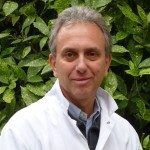Link to Pubmed [PMID] – 23829968
J. Clin. Virol. 2013 Sep;58(1):288-91
Merkel cell polyomavirus (MCPyV) is thought to be the etiological agent of Merkel cell carcinoma, but little is known about its distribution and modes of transmission. We conducted seroepidemiological surveys in more than 1000 individuals, from two populations from Cameroon. Overall MCPyV seroprevalence was high in both populations (>75% in adults). Data from the first population, comprising mainly children, indicated that MCPyV infections mostly occurred during early childhood, after the disappearance of specific maternal antibodies. Results from the second family-based population provided evidence for familial aggregation of MCPyV infection status. We observed significant sib-sib correlation (odds ratio=3.42 [95% CI 1.27-9.19], p=0.014), particularly for siblings close together in age, and a trend for mother-child correlation (OR=2.71 [0.86-8.44], p=0.08). Overall, our results suggest that MCPyV infection is acquired through close contact, possibly involving saliva and/or the skin, especially between young siblings and between mothers and their children.

